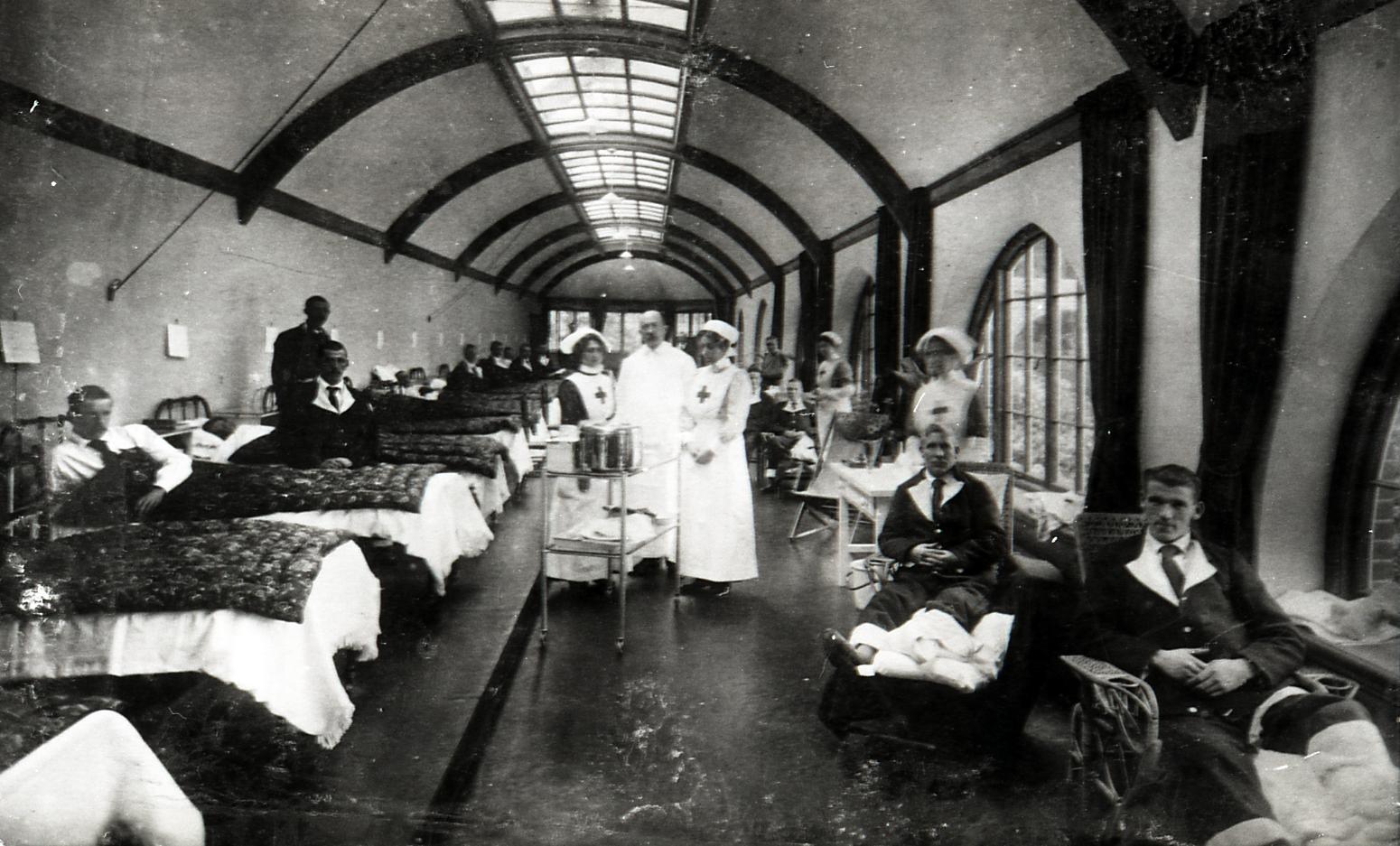
“Go Home and Sit Still”: WWI and women’s colleges at Oxford
by Emily Frisella | March 2, 2015
During the First World War, enrolment at Oxford plummeted. In 1914 Oriel had been home to 133 undergraduates; in 1917, only ten remained. Over the course of the war, 14,561 members of Oxford University enlisted and by 1918 approximately 20 per cent of those men were dead. As the town grew into a centre for military training, medicine, and refugee relief, the emptying university buildings were repurposed as hospital space. Despite the disruption caused by the war, enrolment at many women’s colleges increased over the following years. At St Hugh’s enrolment more than doubled, rising from 45 students in 1915 to 107 by 1919. Women students, who could sit exams but not yet earn degrees, became the most academically active in the university.
Women who volunteered to join the war effort were initially rebuffed by government and military officials. In 1914, when Dr Elsie Inglis presented the War Office with a plan for a system of hospitals across Europe that would be staffed by women, she was asked to “go home and sit still”. Instead, Dr Inglis contacted other European governments and founded the Scottish Women’s Hospitals in Serbia and France. Many of the students and faculty members who left women’s colleges at Oxford during the war found work at the Scottish Women’s Hospitals and the Friends’ War Victims Relief Committee, organisations that were willing to take on women nurses early in the war.
For the students who remained in college at Oxford, the war could feel eerily close. Infantry battalions and Royal Flying Corps cadets were accommodated at the nearly-empty men’s colleges and used University Parks as a training ground. Cutting through the parks on the way to a tutorial, St Hilda’s student Doris Dalglish was struck by the sight of dummies ready for bayonet practice, “nice, fat, well-stuffed sacks into which a man may dig the blade again and again”. Lady Margaret Hall was considered briefly as a potential convalescent home for men recovering from shell shock, but its proximity to the military drills in the parks quickly ruled it out.
The 3rd Southern General Military Hospital, established in the autumn of 1914, was initially housed in New College and the Examination schools, but in March 1915 the hospital expanded, requisitioning Somerville to house more wounded soldiers. The resulting search for a new space for Somerville’s students was riddled with questions of propriety. Oriel agreed to host Somerville’s students and faculty for the duration of the war, but the provost faced criticism from those who felt it was inappropriate for women to take up residence in a men’s college. In fact, college administrators had chosen to rent the St Mary Hall quadrangle at Oriel because it was easily separable from the main body of the college. After investigating Somerville’s temporary home, the Oxford Mail reported that the passage between St Mary Hall and the rest of Oriel had been walled off with “a purpose and determination that were worthy the mediaeval bricking-up of a nun”, describing the new barrier as “the most forbidding venture-no-further kind of wall ever seen”.
Somerville’s Principal, Emily Penrose, emphasised to her students the paramount importance of proper social conduct. The presence of women at Oriel, after all, was quite a cause of alarm to some: historian Judy Batson writes of one episode in which “an elderly man outside Oriel exclaimed in horror when he caught sight of a young woman entering a college gateway with flowers in her arms”.
During her first term at Somerville in 1914, Lucy Maria Wood established a reputation as one of the college’s more rebellious students. In the spring of 1915, she left Somerville to train as a VAD (Voluntary Aid Detachment), then took up a posting as a nurse in Cambridge. Wood was promptly dismissed for “indecent conduct” after she was spotted wearing jewellery and makeup on duty, and still more scandalous, riding on the back of a man’s motor bike. Undeterred, she found a position in a French military hospital.
After having their college displaced by a military hospital, Somerville students seem to have felt more compelled than others to choose war work over academic work. Early in 1914, Grace Proctor took a yearlong leave to work for the Soldier’s and Sailor’s Wives Association. The same autumn, Charis Barnett left college to work first as an interpreter and then train as a midwife, eventually taking up a volunteer post at a Quaker-run maternity hospital in Châlons-sur-Marne. Vera Brittain, a Somerville graduate and the author of Testament of Youth, trained first as a VAD in England then after hearing of her fiancé’s death in 1915 applied for a posting abroad. Somerville students were leaving for war work at such a rate that H.A.L. Fisher, the president of the Board of Education, addressed the college directly in his 1917 speech encouraging women students to remain at Oxford. Fisher’s conviction that women’s education was critical to the success of post-war society shows the growing impact of the war on attitudes to women in the university: “Women training for the high profession of teaching,” he told students, “are in a very real sense equipping themselves for a valuable and expert branch of National Service.”
In fact, women were equipped for all sorts of “valuable national service”. During the war, women were permitted to study medicine at Oxford for the first time, in part because of the military’s growing demand for trained medical staff (though the university set up a separate dissecting room for women to avoid any indecency or embarrassment over the discussion of bodily functions). Dr Anne Manuel notes that during the same period, “women started to lecture at the university, something that had not been considered before, and started to make names for themselves as academics.” Even so, some male faculty members still refused to lecture to women students. While the war brought institutional changes, social mores were harder to challenge.
Celebrations broke out in Oxford when news of the 1918 armistice arrived, but for propriety’s sake, women students celebrated separately from the few male students remaining at Oxford. Somerville held private dances and dinners within the confines of St Mary’s Hall, but the bricked-up archway separating the quad from the rest of Oriel would not stand for long.
The Somerville Log Book describes the events that came to known as “The Pickaxe Incident” as follows: “On the night of Thursday June 19th 1919 certain members of Oriel JCR expressed their desire to return to S Mary Hall in a somewhat unusual but practical manner. After prolonged bombardment on the intervening wall a breach was effected through which several undergraduates jumped into the quad.” Classics tutor Hilda Lorimer, “roused by the commotion”, put on her hat and confronted the Oriel students. According to Somerville secretary Vera Farnell, “Miss Lorimer’s appearance and her words – ‘Gentlemen have the courtesy to return to your own quarters at once without delay’ – routed revellers, who turned and fled.” By this time, Somerville’s principal Emily Penrose had reached the quad. After consulting with Oriel’s provost, Somerville’s SCR agreed to “guard the hole throughout the night” in hour-long shifts, though, Farnell noted, “the hours went by without a sound.”
Penrose worried that the incident might “get into the papers”. News coverage might tarnish the college’s reputation, suggesting that Somerville women were somehow mixed up in indecent behaviour. The first women students at Oxford faced pressure to perform to both social and academic standards, to prove that women too deserved a place in the world of academia. They got one step closer to this recognition in 1920, when women were first formally admitted to degrees at Oxford. In the following year, Vera Brittain, one of the few students who returned from the war to finish her course at Somerville, graduated with a degree in history. Brittain struggled with the return to university life, but her studies gave her time to come to terms with the calamity of war. “I was beginning to suspect that my generation had been deceived, its young courage cynically exploited, its idealism betrayed,” she wrote. “It’s my job now, to find out all about it, and try to prevent it, in so far as one person can, from happening to other people in the days to come.”




